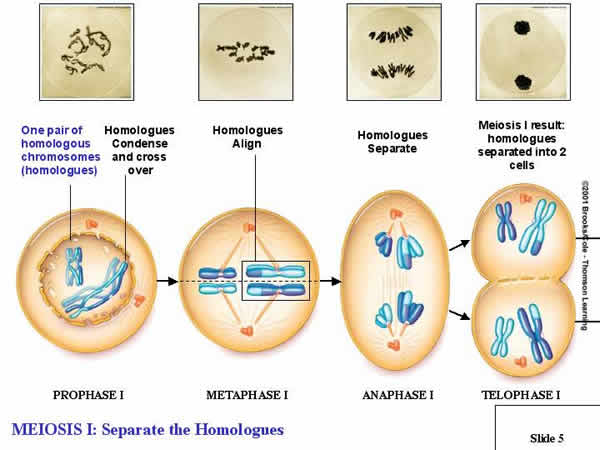
| HOME | MITOSIS | MEIOSIS II | WORKCITED |
|
KEY
TERMS TO KNOW:
Meiosis
is another system of division just like
Mitosis. Meiosis takes place in
organisms for the creation of gamete, sperm, and egg cells. Four
haploid cells are the result of
meiosis. Each one is genetically diverse. For four haploid
cells to be produced,
meiosis first has to go through two segments of cell division: Meiosis
I and
Meiosis II
Meiosis
I occurs in five stages, which are similar to the steps of mitosis in
other eukaryotic
cells: prophase I, metaphase I, anaphase I, telophase
I, and cytokinesis I.
Meiosis
II can be divided into stages just like as meiosis
I but resulting in four haploid
cells: prophase II, metaphase II, anaphase II, telophase II, and
cytokinesis II.
MEIOSIS I Prophase I
Two chromosomes group together and combine to form tetrads, this process is called synapsis. Then genetic material then crosses over between the two chromosomes along several points called chiasmata. Each haploid cell will be genetically diverse because of the genetic material being crossed over. The nuclear envelope erupts, centrosomes side to the poles of the cell, and the spindle forms connects with the kinetochores. Metaphase I Bivalents align at the metaphase plate. The orientation is random, with either parental homologue on a side. Anaphase I Chromosomes dueling two chromatids each move to opposite poles. Daughter cells are now haploids and the chiasmata separates Telophase I The cell continues to grow longer, and the mitotic spindle starts to fall apart. A new nuclear envelope forms at each end of the cell and the chromosomes within unfold into chromatin. Cytokinese I At the end of this stage, two different haploid cells have been formed. The cytoplasm and organelles divide between the two haploids.  |
BACK TO TOP
LAST UPDATED: 16 July 2009
© Copyright 2009 Raymond P. Dinh
E-MAIL ME